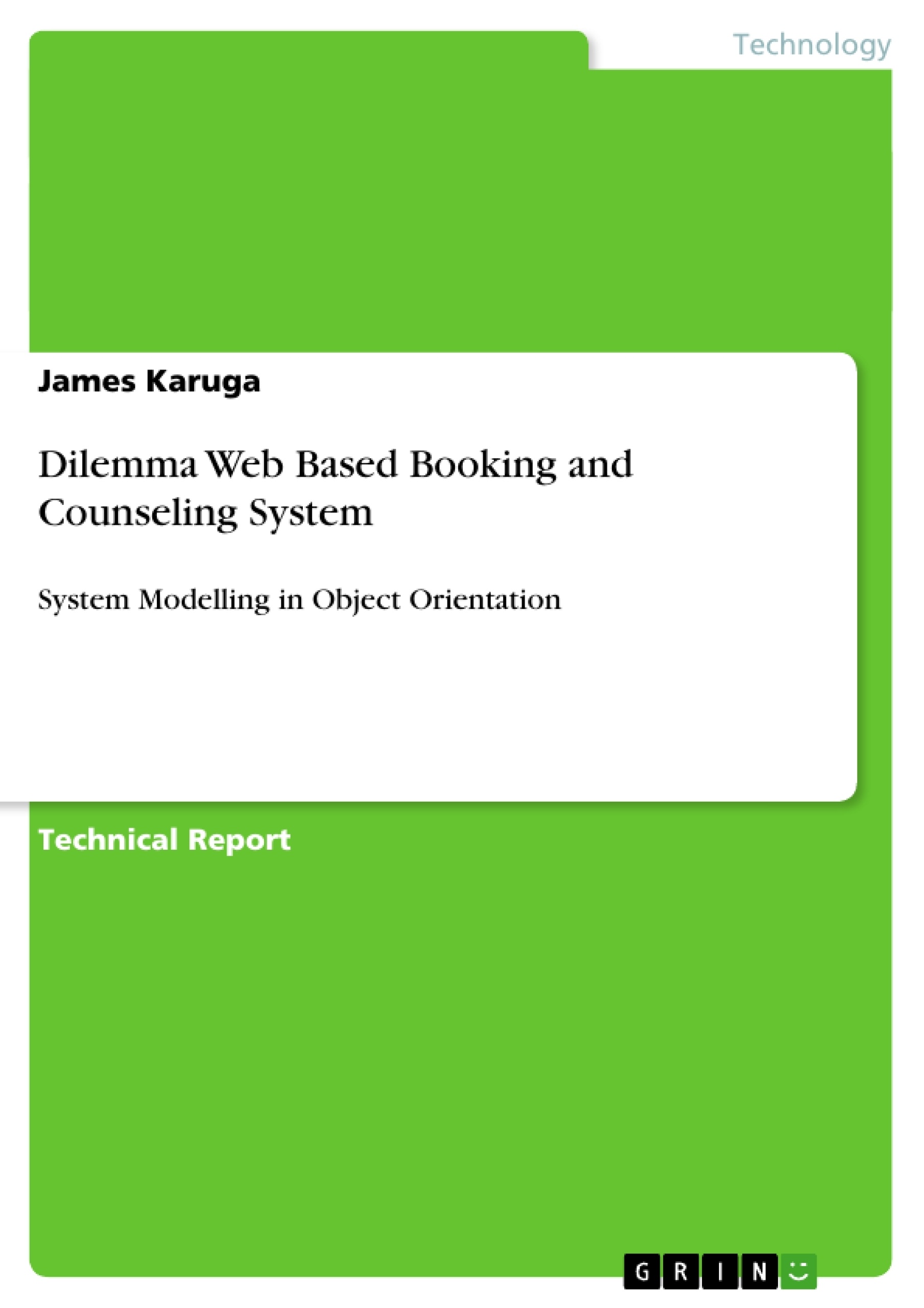This web based booking and counseling project was initially conceived for Dilemma Counseling
Services as a web system, offering counseling to masses (refer to project proposal). The idea
then was to have an online portal where clients can post problems and counselors respond to
them. However the core issue was, whether it would be done for free at the expense of Dilemma
Counseling time and finances. But as the idea of the web based counseling system was
brainstormed by top management, new requirements arose. To maximize potential of the web
based system proposed, the management realized their booking system was a mess and resulted
in data duplication and clashing bookings. The ineffectual booking system then in place brought
constant complaints from clients whose counseling sessions clashed. The Dilemma Staff
contracted me to offer expertise on if counseling and booking can be incorporated into a web
based system that is financially viable this was possible. So I adopted a Unified Software
Development Process (USDP) because after interviewing the various staff I was not satisfied
with the feedback. Thus I choose USDP as the software development method since it allows new
requirements to be factored at any project stage. Sure enough as the software development
process progressed new requirements arose like online counseling system, processing payments
made and assigning username and passwords for clients who pay but prefer online counseling as
opposed to face to face counseling. The system allows staff to book clients remotely online via
secure log in. The clients counseled can have their progress tracked easily via the secure
counseling chat system. I stuck to the USDP process and working on each workflow and
resultant artifacts like Unified Modeling Language diagrams to ensure the project was well
modeled to be realized in construction and transition phases.
Inhaltsverzeichnis (Table of Contents)
- Project Background
- Project Plan
- Road Map and Methodology
- Object Modeling Phases
- Unified Software Development Process
- Development Methodologies
- Project Inception
- Design and Modeling
- Events Flow
- Feasibility Study
- System Design
- Interface Design
- Risk List
- State Diagram
- Requirements Modeling
- System Construction
- User Manual
- Test Plan
- Project Transition to Users
- Project Appraisal
- Appendix
Zielsetzung und Themenschwerpunkte (Objectives and Key Themes)
This project aims to develop a web-based booking and counseling system for Dilemma Counseling Services. The project addresses the need for a more efficient booking system and explores the possibility of integrating online counseling services. The system was initially conceived as a platform for clients to post problems and receive responses from counselors. However, the project evolved to address the shortcomings of Dilemma Counseling's existing booking system and to explore the feasibility of online counseling. Key themes explored in this project include:- Development of a user-friendly web-based system for booking counseling sessions
- Exploration of the feasibility and benefits of online counseling
- Implementation of a unified software development process to accommodate evolving requirements
- Integration of secure login and payment processing functionalities for online counseling
- Development of a secure counseling chat system to track client progress
Zusammenfassung der Kapitel (Chapter Summaries)
- Project Background: This chapter introduces the project's origins and initial objectives, focusing on the need for an improved booking system for Dilemma Counseling Services and the potential for a web-based counseling platform.
- Project Plan: This chapter outlines the project's roadmap, methodology, and development process. It introduces the Unified Software Development Process (USDP) as the chosen method, highlighting its ability to accommodate changing requirements.
- Project Inception: This chapter delves into the initial phases of the project, including the identification of user needs, the development of a project scope, and the establishment of project goals and objectives.
- Design and Modeling: This chapter focuses on the design and modeling of the system, including the creation of Unified Modeling Language (UML) diagrams and the exploration of various aspects of the system's functionality.
- System Construction: This chapter details the implementation phase of the project, including the development of the user interface, the coding of the system's logic, and the testing of the system's functionality.
- Project Transition to Users: This chapter discusses the process of transferring the system to users, including training, support, and ongoing maintenance.
Schlüsselwörter (Keywords)
This project focuses on the development and implementation of a web-based booking and counseling system. Key terms and concepts include: online counseling, booking system, unified software development process, secure login, payment processing, client progress tracking, and counseling chat system. The project explores the feasibility and potential benefits of integrating online counseling services into existing counseling practices. The project also emphasizes the importance of a user-friendly interface, secure data management, and a comprehensive development process to ensure the success of the system.- Quote paper
- James Karuga (Author), 2008, Dilemma Web Based Booking and Counseling System, Munich, GRIN Verlag, https://www.grin.com/document/199185



